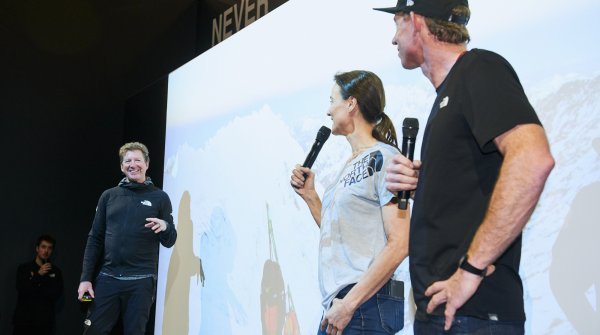
ISPO.com: How do you view the development of the US sporting goods and outdoor industry?
Dieter Tremp: There are plenty of reasons for optimism for the US sporting goods business, especially in the outdoor category. The outdoor lifestyle is deeply established with the US consumer. Demand and use is huge and continues to grow. Therefore, any existing challenges for brands and retailers mainly tend to have their origins in structural issues.
At the core of problems lies the tension between price and innovation. Truly dynamic and innovative brands as well as authentic retailers who provide their customers with an inspiring shopping experience don’t have to be too worried about competitive trends, including the rapid emergence of technology in retailing and distribution. Stores and brands are actually very successful when actively using digital means, like web presence and engaging in social media, to deepen the affinity among designers, brands, specialty shops, athletes and enthusiasts. Of course, this formula for success requires constant active communication with the entire market place.
Who is facing particularly tough challenges?
A particular challenge exists for those brands and retailers that establish their market presence primarily based on price. For them, key requirements are not innovation and authenticity but discounts and margins. Of course, both approaches are legitimate. Brands and retailers simply must regard the realities of their approach in their strategy. Standard products should be readily available at a minimum price; while a truly innovative product exists almost entirely independent of price – but it absolutely must be presented and explained with specialty expertise.
You can clearly sense this distinction here in America, where innovation and short-lived trends are part of the national culture, much more so than in Europe. In addition, generally much sparser population across the vast continent has historically presented retailers in entire regions with difficult competition first from huge catalog companies and later from internet retailers.
How does the US industry value tradeshows?
US business managers are particularly focused on the direct result and measurable value of each of their investments. Every tradeshow is evaluated individually. Attendance stats of exhibitors and buyers implicitly show the true value potential for participating companies. Nobody will spill crocodile tears, if a tradeshow can’t fulfill its core role any longer successfully. There are plenty of examples, such as the long-forgotten Super Show, NSGA, ASR, FFR etc. Any well-run tradeshow which is tightly developed along market needs and conditions is regarded as decidedly positive and worth the necessary investment in money and time. In outdoor, as long as specialty retailers of all sizes continue to be of central importance to the market, a good tradeshow will be worth it as well. Bringing brands and retailers together actively and in person is the most efficient investment to reach and to excite consumers on the entire continent and to have them buy your product.
Which criteria are key to the success of an outdoor tradeshow in the US?
Tradeshow format, location and dates are really the only true variables with which a show organizer can and must play. The more diverse a market, the more obvious it is that any decision will always end up representing a compromise. Success in making the right compromise decision requires quite a lot of sensitivity and a deep understanding of market factors and conditions.
The question of the right format is the easiest to pose, because in general it is about the debate whether a tradeshow can simultaneously function as a consumer show. Here in the US, in the outdoor market the answer continues to be an unambiguous “no” as long as specialty retailing is expected to play its central role in the market. However, intensive media work around the show can create much value for consumer marketing as well. This requires of the organizer a very professional network of media connections. Certainly, exhibitors as well as retailers value seeing TV cameras and journalists at their tradeshow – it can help tremendously in their own B2C marketing.

What is the importance of a tradeshow’s location in the US?
Show location is of great importance, indeed. Size of the exhibition halls, the city’s accessibility, in particular by air, and available hotel space are of key importance. If in addition the show location also reflects the core features of the sport, that’s a significant plus. In the case of Outdoor Retailer’s 2018 move from Salt Lake to Denver, politics, too, played a central role for the first time. Several of Utah’s recent political decisions were regarded as extremely damaging to the environment and had made it almost impossible for the core of the outdoor movement to stay in Salt Lake. Denver, in more environmentally-friendly Colorado, offered itself as logical alternative, even if the tradeshow halls there present more challenges than those in Salt Lake.
The truly critical change for the OR shows is the new show calendar starting in 2018/19. The new compromise of an OR’s Summer Market in June reflects how big and important the portion of store revenue from softgoods has become for outdoor retailers. The increasing retailing competition from e-commerce shows its influence here as well.
In terms of winter product, the 2018 results of the merger of the outdoor and the snowsports tradeshows have been very positive and were applauded by the industry. Still, this hadn’t solved the seasonal date problems for textile brands. That’s why an additional Outdoor Retailer tradeshow with focus on softgoods will take place for the first time in November of 2018. Whether this innovation will prove to bring success to the market will probably only become obvious within the next two to three years.
In 2019, the European tradeshow OutDoor will be held in Munich for the first time, as OutDoor by ISPO. How has the reaction to this move been in the USA?
Outdoor companies from North America have long viewed the two key European tradeshows, ISPO MUNICH in winter and OutDoor in summer, as central marketing and sales platforms for all of Europe, not just for the German-language region. A truly international reach, beyond the respectable size of the German potential, is particularly important for American brands. Cosmopolitan Munich clearly provides that.
Here in the US, OutDoor’s move to Munich has been welcomed as a logical, positive and productive step for the market. The adjusted OutDoor dates at the end of June 2019 have been applauded as a very good compromise as well. I believe US brands from the outdoor industry as well as from other related sectors will exhibit at OutDoor by ISPO with much optimism and enthusiasm.
Dieter Tremp has worked in the US since 1986, including many years as head of Outdoor Retailer tradeshows and publications. As specialist in global sporting goods markets, Tremp acts as an independent consultant and contact for ISPO’s customers in the US.

 OutDoor by ISPOOutDoor in transition
OutDoor by ISPOOutDoor in transition
- Awards
- Mountain sports
- Bike
- Fitness
- Health
- ISPO Munich
- Running
- Brands
- Sustainability
- Olympia
- OutDoor
- Promotion
- Sports Business
- Textrends
- Triathlon
- Water sports
- Winter sports
- eSports
- SportsTech
- OutDoor by ISPO
- Heroes
- Transformation
- Sport Fashion
- Urban Culture
- Challenges of a CEO
- Trade fairs
- Sports
- Find the Balance
- Product reviews
- Newsletter Exclusive Area
- Magazine



